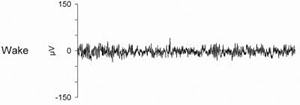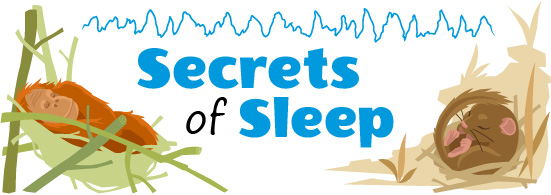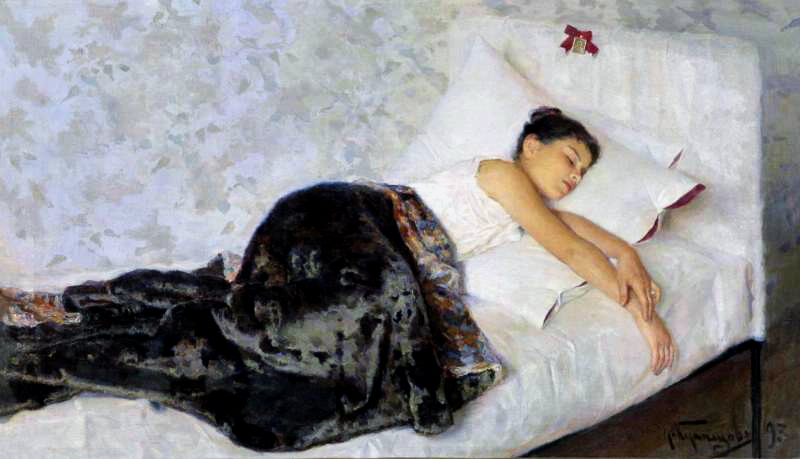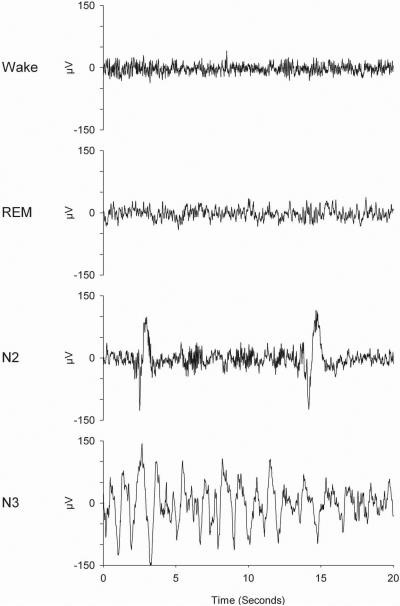Studying Sleep

Studying sleep is hard. When people are sleeping, we can’t ask how it feels or how their thinking changes because, well, they’re sleeping. Luckily, scientists have invented a clever way of measuring changes in brain activity during sleep.
The Brain Wave Monitor
Most sleep scientists use an electroencephalogram (EEG) to study how the brain changes between waking and the different stages of sleep. Now, “electroencephalogram” is a long word, but we can guess its meaning by breaking down the word into its three parts:
- Electro – electrical
- Encephalo – head
- Gram – a type of message or picture

If we put the meaning of the three parts of “electroencephalogram” together, we can guess that an EEG is a picture of the electrical signals from the head. Indeed, scientists use EEG machines to monitor electrical brain signals.
The EEG machine records information gathered from electrodes that are attached to a cap worn on the head. Because the process of recording EEGs is not interactive, this method is perfect for studying brain activity during sleep.
What Can EEG Tell Us?
To the untrained eye, an EEG recording looks like a bunch of squiggly lines. However, we can get an idea of how (or if) brain activity changes between wake and different sleep stages by comparing different EEG recordings.

To the right is an example of EEG recordings from a 21 year old woman. When you compare the recordings from when she is awake (Wake), in REM sleep (REM), and in NREM sleep (N2, N3), what do you notice?
First, you should notice that none of the EEG recordings are flat lines. This shows that the woman’s brain remains active whether she is awake or asleep. Second, you may notice that the REM and NREM recordings look different from each other. Waves during REM sleep are smaller and more frequent than waves during NREM sleep. This means that your brain is going through different processes during REM sleep than during NREM sleep . And last, you’ll notice that the brain signals look very similar during Wake and REM sleep. This suggests that the brain is actually very active during REM sleep almost as active as when the person is awake and going about their day.
Read more about: Secrets of Sleep
Bibliographic details:
- Article: Studying Sleep
- Author(s): Dr. Biology
- Publisher: Arizona State University School of Life Sciences Ask A Biologist
- Site name: ASU - Ask A Biologist
- Date published: 21 Jun, 2017
- Date accessed: 22 January, 2025
- Link: https://askabiologist.asu.edu/studying-sleep
APA Style
Dr. Biology. (Wed, 06/21/2017 - 15:35). Studying Sleep. ASU - Ask A Biologist. Retrieved from https://askabiologist.asu.edu/studying-sleep
Chicago Manual of Style
Dr. Biology. "Studying Sleep". ASU - Ask A Biologist. 21 Jun 2017. https://askabiologist.asu.edu/studying-sleep
MLA 2017 Style
Dr. Biology. "Studying Sleep". ASU - Ask A Biologist. 21 Jun 2017. ASU - Ask A Biologist, Web. https://askabiologist.asu.edu/studying-sleep

Learn more about the parts of the brain and what they do in our story A Nervous Journey.
Be Part of
Ask A Biologist
By volunteering, or simply sending us feedback on the site. Scientists, teachers, writers, illustrators, and translators are all important to the program. If you are interested in helping with the website we have a Volunteers page to get the process started.





